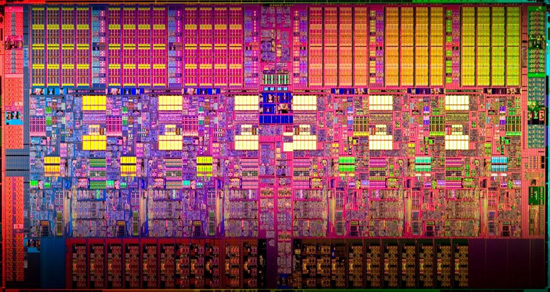The Core i7 980X Review: Intel's First 6-Core Desktop CPU
by Anand Lal Shimpi on March 11, 2010 12:00 AM EST- Posted in
- CPUs
Final Words
I have to say that Intel's Core i7 980X is the first Extreme Edition CPU that I've ever gotten excited about. In the past you used to have to choose between more cores or high clock speeds. Thanks to power gating and Gulftown's PMU, those days are over. The 980X gives you its best regardless of what you throw at it. Lightly threaded apps benefit from the larger L3 cache and heavily threaded apps take advantage of the extra cores. The performance advantage you get at the low end ranges from 0 - 7%, and on the high end with well threaded code you're looking at an extra 20 - 50% over the Core i7 975. Even more if you compare to a pedestrian processor. There are a few cases where the 980X does lose out to the Core i7 975 thanks to its higher latency L3 cache, but for the most part it's smooth sailling for the 6-core beast.

The performance advantage comes at no extra power cost either. Enabling 6 cores on a 32nm process means that the die actually got smaller and power consumption remained mostly unchanged. It really is the best of both worlds, at least for a 130W chip. It's almost Conroe-like in its ability to dominate the charts without any technical limitations. If money were no object, the Core i7 980X is clearly the best you can get.
The only problem is price, as is always the case with these Extreme Edition processors. While I don't expect 6-core CPUs to trickle down to the mainstream, if we had a version priced at ~$500 it would be an amazingly easy sell. I wonder where Intel will price the Core i7 970, allegedly also a 6-core Gulftown derivative. We'll have to wait another quarter to find out.
Even taking into account price, if you do any significant amount of compute intensive 3D work, video encoding or Excel modeling, the Core i7 980X is worth it. If you're the type of user who always buys the Extreme Edition knowing that you can get better bang for your buck further down the lineup, this time you're actually getting your money's worth. On the desktop, the next 12 months are fairly stagnant in terms of CPU performance improvements. We'll see a clock bump to the 980X at the beginning of 2011, but it'll be even longer before we get a replacement.

There is of course the higher powered alternative. You could pick up a dual-socket Xeon board and a pair of quad-core Nehalem Xeons for a bit more than a X58 + 980X. You'd end up with more cores, albeit with a higher power budget and higher price tag. The Core i7 980X is such a difficult processor to recommend. It's something I'd personally never spend the money on. But if I needed more compute in a single chip, it's really the only thing that could scratch that itch.










102 Comments
View All Comments
Anand Lal Shimpi - Thursday, March 11, 2010 - link
That depends on the board I believe. Intel's DX58SO may not post without the BIOS update.Take care,
Anand
Jammrock - Thursday, March 11, 2010 - link
One small title error. Intel's Xeon X7000-series CPUs are the first hex-core processors from Intel. Those are server only, but they are out there.http://ark.intel.com/Product.aspx?id=36947&cod...">http://ark.intel.com/Product.aspx?id=36...16M+Cach...
Gulftown is the first desktop hex-core though.
Anand Lal Shimpi - Thursday, March 11, 2010 - link
Corrected :)Take care,
Anand
artifex - Thursday, March 11, 2010 - link
3x cores and threads for less than 2x the TDP of their dual cores? sexy!Isaac the k - Thursday, March 11, 2010 - link
I must say, I do find this rather exciting.But since I'm running a poorly threaded data-simulation app with extremely high throughput, I'm debating whether the extra latency vs. the larger shared cache could potentially harm performance.
If it wouldn't, I might actually request one for what my office is doing right now...
mikeblas - Thursday, March 11, 2010 - link
Aren't the Xeon E7450, Xeon L7455, and Xeon X7460 all six-core Intel processors that were released before this processor?semo - Thursday, March 11, 2010 - link
If I understand this right Nahalem is the name of the micro architecture and not any CPU in particular. On page 2, the first die shot is captioned Nehalem. Shouldn't it be Bloomfield?BTW Anand, you are doing a good job demystifying desktop products but the mobile space is even worse
arandale http://ark.intel.com/ProductCollection.aspx?codeNa...">http://ark.intel.com/ProductCollection.aspx?codeNa... vs clarkdale http://ark.intel.com/ProductCollection.aspx?codeNa...">http://ark.intel.com/ProductCollection.aspx?codeNa...
vPro is even more confusing. E.g. AMT KVM is supposed to work on AMT 6.0 + on chip GPU yet the i3 don't apply... or the i5-661 http://communities.intel.com/community/openportit/...">http://communities.intel.com/community/...ote-cont...
it would be useful if we could get some articles on mobile chips and/or vPro
iwodo - Thursday, March 11, 2010 - link
Waiting for Sandy Bridge- which will hopefully be the true successor of Core 2 Duo.PCI - Express 3.0, SATA 3.0, USB 3.0 ( Light Peak will be even better ), Bluetooth 4.0.
AnnonymousCoward - Saturday, March 13, 2010 - link
Light Peak is kinda dumb...I think that's just multi-lane USB3/PCIe, and using light instead of wires is pointless since no one needs really long point-to-point cables. Apple just wants it since they're all about marketing new flashy things. USB3 could just as easily use as many lanes as you want, but it'd be unnecessarily expensive since 1 lane at 5Gbps is much faster than anything.Pessimism - Thursday, March 11, 2010 - link
This is not intel's first 6 core CPU. The 6 core Xeon 7400 was announced in 2008.